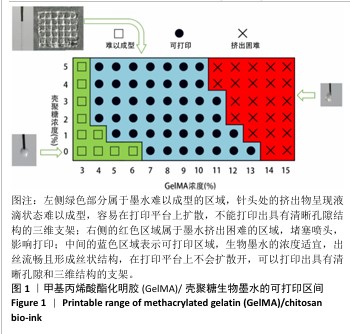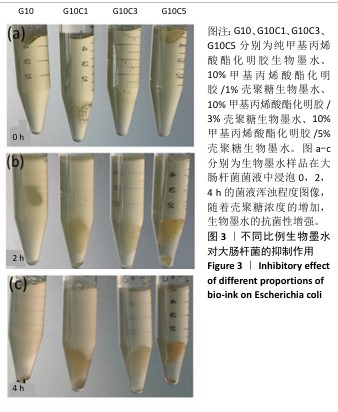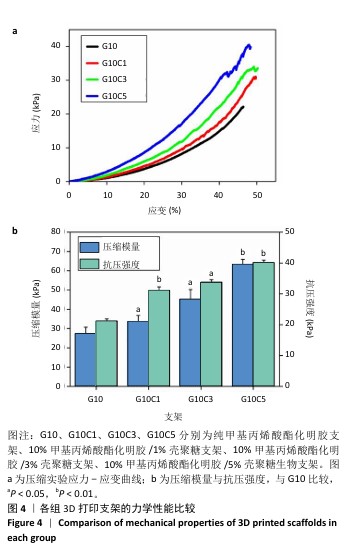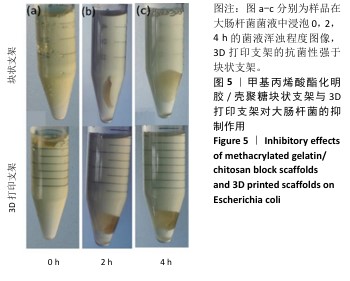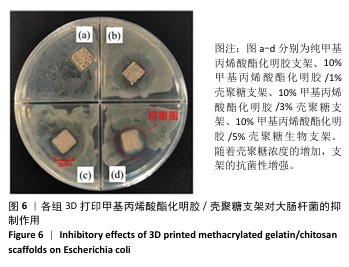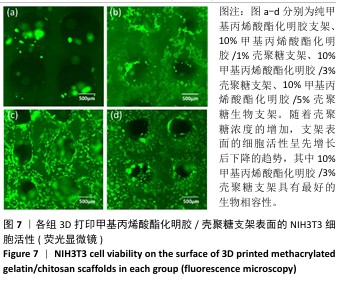[1] RUSSO A, CONCIA E, CRISTINI F, et al. Current and future trends in antibiotic therapy of acute bacterial skin and skin-structure infections. Clin Microbiol Infect. 2016;22:S27-S36.
[2] ZERVOS M J, FREEMAN K, VO L, et al. Epidemiology and outcomes of complicated skin and soft tissue infections in hospitalized patients. J Clin Microbiol. 2012; 50(2):238-245.
[3] MOHITI-ASLI M, POURDEYHIMI B, LOBOA EG. Novel, silver-ion-releasing nanofibrous scaffolds exhibit excellent antibacterial efficacy without the use of silver nanoparticles. Acta Biomater. 2014;10(5):2096-2104.
[4] DUTTA P, RINKI K, DUTTA J. Chitosan: A Promising Biomaterial for Tissue Engineering Scaffolds. Springer Berlin Heidelberg. 2011:45-79.
[5] AHMED S, ANNU, ALI A, et al. A review on chitosan centred scaffolds and their applications in tissue engineering. Int J Biol Macromol. 2018;116:849-862.
[6] AHMADI F, OVEISI Z, SAMANI SM, et al. Chitosan based hydrogels: characteristics and pharmaceutical applications. Res Pharm Sci. 2015;10(1):1-16.
[7] VENKATESAN J, KIM SK. Chitosan composites for bone tissue engineering--an overview. Mar Drugs. 2010;8(8):2252-2266.
[8] ARCHANA D, DUTTA J, DUTTA P. Chitosan-pectin-titanium dioxide nano-composite film: An investigation for wound healing applications. Asian Chitin J. 2010;6:45-46.
[9] USMAN A, ZIA KM, ZUBER M, et al. Chitin and chitosan based polyurethanes: A review of recent advances and prospective biomedical applications. Int J Biol Macromol. 2016;86:630-645.
[10] WU J, LEI J, CHEN M, et al. Synthesis and Characterization of Photo-Cross-Linkable Silk Fibroin Methacryloyl Hydrogel for Biomedical Applications. ACS Omega. 2023;8(34):30888-30897.
[11] GAO J, LI M, CHENG J, et al. 3D-Printed GelMA/PEGDA/F127DA Scaffolds for Bone Regeneration. J Funct Biomater. 2023;14(2):96.
[12] YUE K, TRUJILLO-DE Santiago G, ALVAREZ MM, et al. Synthesis, properties, and biomedical applications of gelatin methacryloyl (GelMA) hydrogels. Biomaterials. 2015;73:254-271.
[13] YING G, JIANG N, YU C, et al. Three-dimensional bioprinting of gelatin methacryloyl (GelMA). Biodes Manuf. 2018;1(4):215-224.
[14] COLOSI C, SHIN SR, MANOHARAN V, et al. Microfluidic Bioprinting of Heterogeneous 3D Tissue Constructs Using Low-Viscosity Bioink. Adv Mater. 2016;28(4):677-684.
[15] CHEN J, HUANG D, WANG L, et al. 3D bioprinted multiscale composite scaffolds based on gelatin methacryloyl (GelMA)/chitosan microspheres as a modular bioink for enhancing 3D neurite outgrowth and elongation. J Colloid Interface Sci. 2020;574:162-173.
[16] MEHDIKHANI M, YILGR P, POURSAMAR SA, et al. A hybrid 3d-printed and electrospun bilayer pharmaceutical membrane based on polycaprolactone/chitosan/polyvinyl alcohol for wound healing applications. Int J Biol Macromol. 2024;282:136692.
[17] GUO W, MAO Y, TANG X, et al. Copper-Loaded Microporous Chitosan Generated within a 3D-Printed Polylactic Acid-Pearl Scaffold: Structure and Performance. ACS Appl Polym Mater. 2024;10:2541.
[18] PEPPAS NA, BURES P, LEOBANDUNG W, et al. Hydrogels in pharmaceutical formulations. Eur J Pharm Biopharm. 2000;50(1):27-46.
[19] HOFFMAN AS. Hydrogels for biomedical applications. Ann N Y Acad Sci. 2001;944: 62-73.
[20] 陈向标.水凝胶医用敷料的研究概况[J].轻纺工业与技术,2011, 40(1):66-68.
[21] BERAM FM, ALI SN, MESBAHIAN G, et al. 3D Printing of Alginate/Chitosan-Based Scaffold Empowered by Tyrosol-Loaded Niosome for Wound Healing Applications: In Vitro and In Vivo Performances. ACS Appl Bio Mater. 2024;7(3):1449-1468.
[22] LIU, LI W, LIU H, et al. Preparation of 3D Printed Chitosan/Polyvinyl Alcohol Double Network Hydrogel Scaffolds. Macromol Biosci. 2021; 21:2000398.
[23] NEGI A, VERMA A, GARG M, et al. Osteogenic citric acid linked chitosan coating of 3D-printed PLA scaffolds for preventing implant-associated infections. Int J Biol Macromol. 2024;282:136968.
[24] TEJAL VP, HEXIU J, SAYAN DD, et al. Zn@TA assisted dual cross-linked 3D printable glycol grafted chitosan hydrogels for robust antibiofilm and wound healing. Carbohydr Polym. 2024;344:122522.
[25] ISHIHARA M, NAKANISHI K, ONO K, et al. Photocrosslinkable chitosan as a dressing for wound occlusion and accelerator in healing process. Biomaterials. 2002;23(3):833-840.
[26] 季冬青,孙丹丹,和焕香,等.壳聚糖抗菌活性研究进展[J].辽宁中医药大学学报,2018,20(3):82-85.
[27] SU Y, LIU Y, HU X, et al. Caffeic acid-grafted chitosan/sodium alginate/nanoclay-based multifunctional 3D-printed hybrid scaffolds for local drug release therapy after breast cancer surgery. Carbohydr Polym. 2024;324:121441.
[28] HUI I, PASQUIER E, SOLBERG A, et al. Biocomposites containing poly(lactic acid) and chitosan for 3D printing–Assessment of mechanical, antibacterial and in vitro biodegradability properties. J Mech Behav Biomed. 2023;147:106136.
[29] ARTEMIS P, IOANNA K, ANNA M, et al. Optimization of chitosan-gelatin-based 3D-printed scaffolds for tissue engineering and drug delivery applications. Int J Pharmaceut. 2024;666:124776.
[30] KOUMENTAKOU I, NOORDAM MJ, MICHOPOULOU A, et al. 3D-Printed Chitosan-Based Hydrogels Loaded with Levofloxacin for Tissue Engineering Applications. Biomacromolecules. 2023;24(9):4019-4032.
[31] CUI H, CAI J, HE H, et al. Tailored chitosan/glycerol micropatterned composite dressings by 3D printing for improved wound healing. Int J Biol Macromol. 2024;255:127952.
[32] SHAHROUDI S, PARVINNASAB A, SALAHINEJAD E, et al. Efficacy of 3D-printed chitosancerium oxide dressings coated with vancomycin-loaded alginate for chronic wounds management. Carbohydr Polym. 2024;349:123036.
[33] LI S, XU Y, ZHENG L. High Self-Supporting Chitosan-Based Hydrogel Ink for InSitu 3D Printed Diabetic Wound Dressing. Adv Funct Mater. 2024;1:241625.
[34] ZHANG W, SHI K, YANG J, et al. 3D printing of recombinant collagen/chitosan methacrylate/nanoclay hydrogels loaded with Kartogenin nanoparticles for cartilage regeneration. Regener Biomater. 2024; 11:97.
[35] CH S, MISHRA P, PADAGA SG, et al. 3D‐Printed Inherently Antibacterial Contact Lens‐Like Patches Carrying Antimicrobial Peptide Payload for Treating Bacterial Keratitis. Macromal Biosci. 2024;24(4):2300418.
[36] PAHLEVANZADEH F, EMADI R, KHARAZIHA M, et al. Amorphous magnesium phosphate-graphene oxide nano particles laden 3D-printed chitosan scaffolds with enhanced osteogenic potential and antibacterial properties. Biomater Adv. 2024;158:213760.
[37] LIU Z, SHI J, CHEN L, et al. 3D printing of fish-scale derived hydroxyapatite/chitosan/PCL scaffold for bone tissue engineering. Int J Biol Macromol. 2024; 274(2):13172.
[38] KOUMENTAKOU I, NOORDAM MJ, MICHOPOULOU A, et al. 3D-Printed Chitosan-Based Hydrogels Loaded with Levofloxacin for Tissue Engineering Applications. Biomacromolecules. 2023;24(9): 4019-4032.
[39] VASEGHI A, SADEGHIZADEH M, HERB M, et al. 3D Printing of Biocompatible and Antibacterial Silica-Silk-Chitosan-Based Hybrid Aerogel Scaffolds Loaded with Propolis. ACS Appl Bio Mater. 2024; 20:697.
[40] SUO H, ZHANG D, YIN J, et al. Interpenetrating polymer network hydrogels composed of chitosan and photocrosslinkable gelatin with enhanced mechanical properties for tissue engineering. Mater Sci Eng C. 2018;92:612-620.
[41] ZHAO X, LIU Y, JIA P, et al. Chitosan hydrogel-loaded MSC-derived extracellular vesicles promote skin rejuvenation by ameliorating the senescence of dermal fibroblasts. Stem Cell Res Ther. 2021;12(1):196.
[42] CROISIER F, JÉRÔME C. Chitosan-based biomaterials for tissue engineering. Eur Polym J. 2013;49(4):780-792.
[43] PÉREZ-DÍAZ M, ALVARADO-GOMEZ E, MAGAÑA-AQUINO M, et al. Anti-biofilm activity of chitosan gels formulated with silver nanoparticles and their cytotoxic effect on human fibroblasts. Mater Sci Eng C. 2016;60:317-323.
[44] FREIER T, KOH HS, KAZAZIAN K, et al. Controlling cell adhesion and degradation of chitosan films by N-acetylation. Biomaterials. 2005;26(29):5872-5878. |
